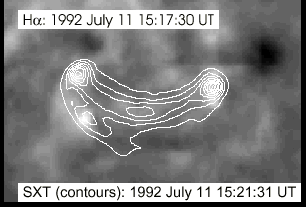Weekly Notes from the Yohkoh Soft X-Ray Telescope
(Week 41, 2002)
Science Nugget: October 11, 2002
A "simple loop flare" up close
Introduction
It is conventional wisdom that there are two flavors of solar flares - the
"eruptive" kind, and the "simple loop" kind. This dates back to a key paper by Pallavicini et al., who
were describing data from Skylab.
Solar flares would be divided into two categories: the eruptive flares
and the simple loop flares, each perhaps with its own physics.
From the
Yohkoh point of view, eruptive flares are much more interesting
(the movies
often look great), but of course we need to pay attention to the other kind
of flare because of the possible differences in the physics.
But is the physics really different?
Certainly some theorists (e.g. Yohkoh's own
Kazunari Shibata)
feel that the basic physics of all flares is
magnetic reconnection.
Perhaps the basic physics of the two types of flares
is not unrelated, if only we could just figure it out.
Note: the X-ray images below are all negative, so that the bright regions
appear dark.
July 11, 1993
There have been many Yohkoh science nuggets dealing with eruptive
flares,
which after all are the most fun and at the same time offer more
substance in terms of understanding the process.
Here we have what looks like a "simple loop" flare.
The reason for this curvature is of course the third dimension: coronal
magnetic loops extend into the corona, and if they are (a) in a vertical
plane, and (b) in the southern hemisphere, there projection will be
concave-up.
Here is our "smiley face flare":
|
A simple flare - large but uncomplicated - observed in soft X-rays
by the Yohkoh soft X-ray telescope.
One can judge the size scale from the individual pixels represented
here: the dimension is about 2,000 km.
Thus the footpoint separation, determined by just counting, is
about 50,000 km, approaching a tenth of the solar radius.
If the loops were half as tall as they were wide, they would appear
as handles (ansae
in the astronomical jargon) just like the
rings of Saturn, but only a few percent of the solar radius in
size.
|

|
Flares of all kinds may show footpoint brightening.
A flare develops impulsively - fast rise, slow decay - and in the rise
phase coronal energy somehow focuses down onto the lower atmosphere.
The "somehow" is probably energy transport by semi-relativistic electrons
accelerated by the flare energy release, at present not understood very
well.
But here is what happens:

|
Footpoint brightenings early in the flare development; a full
loop later on: the material for the loop has been ablated from the
solar chromosphere into the corona as the result of intense
heating at the loop footpoints.
|
The pronounced footpoint brightening seen above (left) is readily
understood: energy released in the corona is guided down magnetic lines of
force, where it heats the previously invisible chromospheric gas; it
expands up into the same loop and makes it visible (right) as it collects
there at high pressure.
Here "high" means about 0.1% of a terrestrial barometric reading, but then
the temperature can be 100,000 times higher!
The flare shown here never displayed dramatic motions, nor any kind of
restructuring.
We believe that this sort of thing must happen, otherwise the energy of
the coronal magnetic field cannot be released.
Since we don't see anything like that, this event seems like a good
candidate to be an energy release ("simple loop flare") from magnetic
twist embedded within a basically unchanging coronal structure.
But was it just a feeble arcade after
all?
However, let us look actually at the chromosphere, via the H-alpha line:

Somehow, this sequence has lost some of its elements, but the message is
clear.
On either side we see a faint bright ribbon that grows as the flare
develops.
This is a characteristic signature of Pallavicini's other type of flare,
the eruptive one.
To check, we can do an overlay of the X-ray contours on the H-alpha
image:
| Here's the confirmation that the flare has arcade-like properties.
The X-ray contours neatly line up on the H-alpha ribbons, as expected. |

|
But we are left with unanswered questions:
Why is one coronal region so much brigher than the other, ie why can't we
actually see the full arcade of loops?
And - if this is really an eruptive flare, why didn't we see it erupt as
we so often do?
Conclusions
Ideally we would have found a clean distinction between Pallavicini's
two classes of flares, but this has in the past
proved difficult.
Almost no parameter of solar flares has a
bimodal distribution
unless one steps back and looks at the distribution of solar energetic
particles (SEPS), as noted by
D. Reames
in particular.
Here too there is ambiguity, and one of the key questions about solar
flares remains unclarified: What is the true role of magnetic reconnection
in the flare process?
[Topical
index] -o- [Chronological
index]
October 11, 2002
Hugh Hudson hhudson@ssl.berkeley.edu
with thanks to J. Khan and Z. Mouradian.



